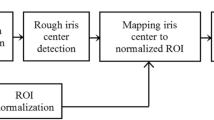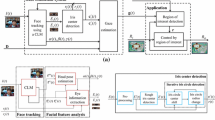Abstract
Remote gaze estimation under natural light is still a challenging problem. Appearance based methods are seriously sensitive to illumination variation in the visual spectrum and usually can hardly handle the problem of head movements. And most existing feature-based gaze estimation methods strongly rely on cornea reflections, which are unstable to glasses, head movements and especially useless for natural light condition. In this paper, we propose a novel feature based gaze estimation method without use of cornea reflections. A stereo camera system is built for the proposed method. Firstly, 3D Active Shape Models (ASM) is reconstructed using stereo vision to represent 3D face structure. Then, without use of cornea reflections, a 3D Iris-Eye-Contours based descriptor is proposed to represent human gaze information. Iris centers are used in natural light just like the pupil centers in condition of near-infrared light. What’s more, precise estimation of head poses based on 3D face structure is employed to rectify the 3D iris centers and eye contours for improving the ability of tolerance to head movements. Experiments on several subjects show that the system is accurate and allows natural head movements under natural light.










Similar content being viewed by others
References
Baluja S, Pomerleau D (1994) Non-intrusive gaze tracking using artificial neural networks. In: Adv Neural Inf Process Syst, pp 753–760
Cerrolaza JJ, Villanueva A, Cabeza R (2008) Taxonomic study of polynomial regressions applied to the calibration of video-oculographic systems. In: Proceedings eye tracking research and applications (ETRA), pp 259–266
Cootes TF, Taylor CJ, Cooper DH, Graham J (1995) Active shape models-their training and application. Comput Vis and Image Underst 61(1):38–59
Duchowski AT (2002) A breadth-first survey of eye-tracking applications. Behav Res Methods Instrum Comput 34(4):455–470
Fischler MA, Bolles RC (1981) Random sample consensus: a paradigm for model fitting with applications to image analysis and automated cartography. ACM Commun 24(6):381–395
Funes Mora K, Odobez JM (2012) Gaze estimation from multimodal kinect data. In: IEEE conference on computer vision and pattern recognition workshops (CVPRW), pp 25–30
Golub GH, Reinsch C (1970) Singular value decomposition and least squares solutions. Numerische Mathematik 14(5):403–420
Group T (2015) Tobii technology products. Accessed 5 January 2014. http://www.tobii.com
Hansen DW, Ji Q (2010) In the eye of the beholder: a survey of models for eyes and gaze. IEEE Trans Pattern Anal Mach Intell 32(3):478–500
Jafari R, Ziou D (2015) Eye-gaze estimation under various head positions and iris states. Expert Syst Appl 42(1):510–518
Lin YT, Lin R Y, Lin YC, Lee GC (2013) Real-time eye-gaze estimation using a low-resolution webcam. Multimed Tools Appl 65(3):543–568
Loy G, Zelinsky A (2003) Fast radial symmetry for detecting points of interest. IEEE Trans Pattern Anal Mach Intell 25(8):959–973
Lu F, Okabe T, Sugano Y, Sato Y (2011a) A head pose-free approach for appearance-based gaze estimation. In: Proceedings British machine vision conference (BMVC), pp 1–11
Lu F, Sugano Y, Okabe T, Sato Y (2011b) Inferring human gaze from appearance via adaptive linear regression. In: Proceedings IEEE Int Conf Comput Vis (ICCV), pp 153–160
Martinez F, Carbone A, Pissaloux E (2012) Gaze estimation using local features and non-linear regression. In: IEEE international conference on image processing (ICIP), pp 1961–1964
Mora KAF, Odobez JM (2014) Geometric generative gaze estimation for remote rgb-d cameras. In: IEEE Comput Soc Conf Comput Vis Pattern Recognit (CVPR), pp 1773–1780
Morimoto CH, Koons D, Amir A, Flickner M (2000) Pupil detection and tracking using multiple light sources. Image Vis Comput 18(4):331–335
Schneider T, Schauerte B, Stiefelhagen R (2014) Manifold alignment for person independent appearance-based gaze estimation. In: IEEE international conference on pattern recognition (ICPR)
Sesma L, Villanueva A, Cabeza R (2012) Evaluation of pupil center-eye corner vector for gaze estimation using a web cam. In: Proceedings eye tracking research and applications (ETRA), pp 217–220
Sesma-Sanchez L, Villanueva A, Cabeza R (2012) Gaze estimation interpolation methods based on binocular data. IEEE Trans Biomed Eng 59(8):2235–2243
Sugano Y, Matsushita Y, Sato Y, Koike H (2008) An incremental learning method for unconstrained gaze estimation. In: Proceedings European conference on computer vision (ECCV), pp 656–667
Sugano Y, Matsushita Y, Sato Y (2010) Calibration-free gaze sensing using saliency maps. In: IEEE conference on computer vision and pattern recognition (CVPR), pp 2667–2674
Sugano Y, Matsushita Y, Sato Y (2013) Appearance-based gaze estimation using visual saliency. IEEE Trans Pattern Anal Mach Intell 35(2):329–341
Sugano Y, Matsushita Y, Sato Y (2014) Learning-by-synthesis for appearance-based 3d gaze estimation. In: IEEE international conference on computer vision and pattern recognition (CVPR)
Tropp J A, Gilbert A C (2007) Signal recovery from random measurements via orthogonal matching pursuit. IEEE Trans Inf Theory 53(12):4655–4666
Valenti R, Sebe N, Gevers T (2012) Combining head pose and eye location information for gaze estimation. IEEE Trans Image Process 21(2):802–815
Williams O, Blake A, Cipolla R (2006) Sparse and semi-supervised visual mapping with the sˆ 3gp. In: IEEE conference on computer vision and pattern recognition (CVPR), vol 1, pp 230–237
Wold S, Esbensen K, Geladi P (1987) Principal component analysis. Elsevier Chemom Intell Lab Syst 2(1):37–52
Xiong C, Huang L, Liu C (2014) Gaze estimation based on 3d face structure and pupil centers. In: IEEE international conference on pattern recognition (ICPR), pp 1156–1161
Xiong P, Huang L, Liu C (2010) Initialization and pose alignment in active shape model. In: IEEE international conference on pattern recognition (ICPR), pp 3971–3974
Zhu Z W, Ji Q (2004) Eye and gaze tracking for interactive graphic display. Mach Vis Appl 15(3):139–148
Acknowledgements
The authors would like to thank all the subjects who highly cooperate with the test process. The authors would also like to thank the Data Research Group at Hanvon Technology for helping to prepare the dataset.
Author information
Authors and Affiliations
Corresponding author
Rights and permissions
About this article
Cite this article
Xiong, C., Huang, L. & Liu, C. Remote gaze estimation based on 3D face structure and iris centers under natural light. Multimed Tools Appl 75, 11785–11799 (2016). https://doi.org/10.1007/s11042-015-2600-y
Received:
Revised:
Accepted:
Published:
Issue Date:
DOI: https://doi.org/10.1007/s11042-015-2600-y




